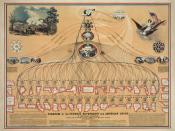Exploitation and economic abuse was not uncommon in the Trans-Mississippi west from 1850-1900, even though the West was promoted as a land of opportunity by the United States Government.
To start off, many Native Americans felt they felt were forcibly diminished by the white man. ÃÂWhen you first came we were very many, and you were few; now you are many, and we are getting very few, and we are poor.ÃÂ Not only that, but the Native American minority was squeezed like a lemon. ÃÂWe are driven into a very little land, and we want you now, as our dear friends, to help us with the government of the United States. We would like to know why commissioners are sent out there to do nothing but rob us and get the riches of this world away from usÃÂ ÃÂ The Native American west was tired of the belittling nonsense fed to them by the government: ÃÂÃÂ we cannot trust President GrantÃÂs agents.
I donÃÂt want any more such men sent out there, who are so poor that when they come out their first thoughts are how they can fill their own pockets.ÃÂ (Document C).
The abused Western population, which in reality spanned across all races, organized a mass exodus to Kansas in 1878, ÃÂIn pursuit of homes in the Southwestern Lands of American, at Transportation Rates cheaper that ever was known before.ÃÂ The troubles of relocation may not be understood by everyday person, who had never undergone such a process; but those who have will grasp the severity of an economic exploitation that forces an entire population to move out (Document D).
Not only were people robbed of their revenues without hesitation, but Mother Nature was robbed of her riches as well. Hydraulic mining scarred the face of the terrain beyond recognition. Hills melted away and disappeared; much of the land mass was being distributed in the riverbeds below; whole valleys were filled with clean washed boulders, and other rocks left behind in the general debacle; possibly fertile land was being defaced in cold blood (Document F).
Amongst the unfortunate were of course the farmers, whose occupation it was to feed the entire American population. The profits that were to be realized from national nourishment were mostly grabbed by manipulative railroad companies, who took advantage of farmerÃÂs distance both from the buying and selling markets. Rates were often four times as large as Eastern rates. No state west of Missouri was able to combat the high rates (Document I).
Not every year was profitless for the farmer. C. Coffin writes in ÃÂHarperÃÂs New Monthly MagazineÃÂ of his successful season: ÃÂSince the furrow was turned in the Red River Valley, there has been no failure of crops from drought, excessive rains, blight, mildew, or other influence of climatology. With good tilth, the farmer may count upon a net return of from eight to ten dollars per acre per annum.ÃÂ A season with nature hindering with the crop therefore produces a ÃÂwide margin of profitÃÂ (Document E).
Other times, however, as seen in Document H, AmericaÃÂs feeding hand was not all that prosperous. ÃÂThis season is without parallel in this part of the country,ÃÂ writes W. M. Taylor. ÃÂThe hot winds burned up the entire crop, leaving thousands of families wholly destitute, many of whom might have been able to run through this crisis had it not been for the galling yoke put on them by the money loaners and sharksÃÂ. Speed bumps in the agricultural field were turned into brick walls by wealthy loan bullies who exploited the farmers without shame, charging as much as fifty percent interest. Others, desperate for a solution, turned to loan sharks. Many had seen their property taken away from them.
There is much evidence to support Western exploitation for nearly fifty years, which was a result of an advertising campaign by the government and an economic exploitation spree by those with political power.





